 |

Interviews -
Face To Face With The Masters
Any citizen of the galaxy may be summoned to answer to the Jedi Council. Here you may read the transcripts of such sessions.
Cellblock 1138 - 1997-1999 - 2000 - 2002 - 2003+
Tim McLaughlin ILM
Technical Director
Name: Tim McLaughlin (Class of '90 '94)
Species: Left Coast Ag
Homeworld: San Rafael, California by way of Longview, Texas
Weapon of Choice: direct eye contact
Vehicle of Choice: '82 Trans Am with T-Tops
Political Affiliation: autocratic |
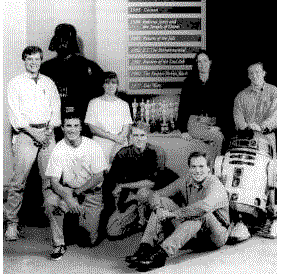
The Aggies at ILM! Tim McLaughlin sits in front of R2-D2.
Special Thanks to Debra Amador at ILM for making this interview
possible. Without her kindness, you wouldn't be reading this!
As many of you know, Texas A&M has a program called the VIZ Lab that teaches the art of computer graphics. Tim
McLaughlin is a graduate of that program and a fellow Fightin' Texas Aggie! Whoop! (def.
whoop - an Aggie expression of extreme joy). You can check out one of his projects,
DREAMDWELLER, by downloading a Quicktime file at the VIZ lab homepage. He's now busily
working away on the Star Wars Prequels, but he was kind enough to answer some questions
for us......
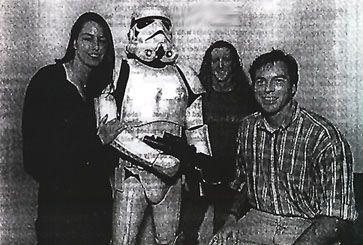
Aggies Mary Beth Haggerty, David Parrish, and
Ted the Stormtrooper hold Tim McLaughlin at blaster-point.
1. How did you end up at Texas A&M? What was your major and what
classes did you take? What classes would you recommend for people interested in animation?
TIM: I was born and raised in Texas and had my sights set on being
an Aggie for as long as I can remember. That the Master of Science in Visualization
Program at A&M opened its doors just before I finished my undergraduate degree was
pure serendipity. I never seriously considered a career in computer graphics until about a
year before entering the Viz Program, and never considered having a job actually making
effects for films until about halfway through my graduate studies.
If I were starting over again, and knew that I wanted to do what I'm
doing now I don't know that I'd plan my curriculum any differently. Most of my interests
were in design, figure drawing, and photography upon entering the Viz Program. What I
added to those skills in graduate school at A&M were technical proficiencies such as
programming and methods for using the computer as a creative tool. I couldn't do my job
here at ILM without a decent combination of both the design and technical aspects of
computer graphics. The trick has always been keeping both sets of skills honed and trying
to stay balanced.
2. What is the workplace like at ILM? Any cool stuff around? Have
you met George Lucas?
TIM: The workplace at ILM is a lot like studying architecture during
my undergraduate days at A&M. We work in teams on films and each individual is
responsible for a particular part of the overall project. We get together as a group every
morning at "dailies" and dissect each others' work. Everybody here works hard
and there's a lot of appreciation shown by coworkers and management alike for doing things
in ways that are better, faster, and generally more exciting than they've been done
before. We have a reputation in the industry for doing the best effects work and there's a
decent amount of pressure that accompanies that reputation. ILM expects a lot of time and
energy, but also pays back for that time with parties, gifts, camaraderie, and
opportunities to work on a good portion of the most challenging work being done in the
industry.
I've never met Mr. Lucas -he keeps inviting my wife and I over for
dinner to discuss story ideas but we're much too busy. On the occasions when I've seen him
around it's either been at a party or here on the ILM lot. In either situation it's cool
to be in the company of a world-class visionary, but at the same time I'm more interested
in his work than his personage. That track probably runs both ways.
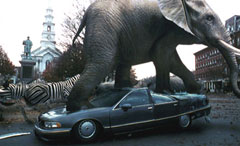
3. What projects have you worked on (specifically, which effects)?
Anything involved with Star Wars?
TIM: The first movie I worked on was 'Jumanji', next was 'Mars
Attacks!', and I'm now involved on the first of the Star Wars prequels. My job title is
Technical Director, with my main area of expertise in handling the technical side of
building CG creatures. I call it creature wrangling, and on a day to day basis the job
entails some combination animating, modeling, and general technical directing (lighting,
rendering, compiling).
On 'Jumanji' I was tasked with creating naturalistic movements in
the skin of the zebras and monkeys. For 'Mars Attacks!' similar "enveloping"
duties continued for the Martians while I also spent quite a bit of time developing
techniques for putting a girl's head on a dog's body (this is the kind of work that makes
me want to get in early and stay late).
On the Prequels I'm again dealing with different creature building
issues, but on a scale much larger than was done for the other two films. It'd be fun to
drop some juicy info here about what we're trying to do and why, but then again we want to
continue to have a reason to keep the word 'Magic' in our company name.
4. What hardware and software do you mainly work with? What would
you recommend for amateur animators to practice on?
TIM: The road to being an animator is a different one than the one
I've taken. The A&M Viz Program is not a training ground for animators, though some
have used it as such. It's actually more of a training ground for Technical Directors.
Above and beyond that, however, it's a place that supports research into the theory and
practice of technology aided design. Computer animation and effects just happen to be one
exciting part of what goes on there.
Back to the question...One of the most important opportunities that
studying in the Viz Program gave me was access to Silicon Graphics workstations running
Softimage and Renderman. This same hardware and software are integral to the way we work
at ILM and my experience with them gave me an edge when I was job hunting.
If someone wants to do what I do, be a Technical Director, then he
or she needs to become proficient in Unix, shell scripting, resource management, perhaps
python or C++ programming. Add to this a well developed sense of 3D design -spaces,
objects, motion and the way light and shadow effect them. Photography, film making,
architecture, sculpture, and color theory are fields which deal with these issues. For my
specific work, I've tried to combine the above mentioned skills with a decent
understanding of bio mechanics, anatomy, and the psychology of visual perception. Oh, and
probably the most important thing is to understand how to work with a team. That sounds
like a cliche, but it's awfully easy to learn how to interface with a computer all day,
compared with learning how to integrate your ideas, vision, and work with that of others.
5. Can you outline the process from first hearing what effects are
needed to what we see on the big screen?
TIM: A good periodical that covers this kind of information is
'Cinefex' magazine. There's usually quite a bit of in depth information following the
latest projects from concept to big-screen in each issue. Aside from what you can find
there I can give a general outline. By the time I see a project the shots we're to work on
are already in storyboard form. Groups of ILM producers and supervisors read scripts,
decide which parts of a story require effects, and then give bids to the movie's
production company. This is often done even before a director or actors are signed to the
film.
From there, if we get the job, all of the shots for a film are
divided into sequences, with each sequence typically having similar effects in its shots.
Teams of artists are being put together whose skills match the challenges of each
sequence. These teams are led by sequence supervisors and grow in size as the project
moves from pre-production into full production. The entire project is led by by a visual
effects supervisor and visual effects producer. It's their job to determine which
techniques, whether digital, practical, or a combination of the two, are used for creating
the effects within the budget of the movie.
By the time film shot on location for the movie begins to arrive at
ILM we hopefully have most of our models built, some test animation complete, and a firm
idea about how to proceed integrating our images into those of the clean shots. Over the
course of the production schedule (on a big film this can be 12 months or more) we work
our way through the shots and sequences. Some shots may be fairly simple, consist of
things we've done many times before, and only take a matter of days to get complete. Other
shots may involve hundreds of elements, new technology, and will take nearly the entire
length of the production schedule to get up to a point where our effects director
considers it a final. At this time the film's director will receive the shot and either
final it or send it back with requested changes.
Once all of the shots for a film have been finaled by the director
we breathe a big sigh of relief, have a big wrap party, and begin thinking about the next
project. By the time the film comes out in the theatres we're usually deeply into
something new. Seeing our work on the big screen can be anti-climatic simply because we've
already seen it so many times. A particularly fun thing, however, is to go and see the
film with a crowd that doesn't know what to expect. Some flaws that make me wince every
time I see them are never noticed, likewise, for some of the sweetest details.
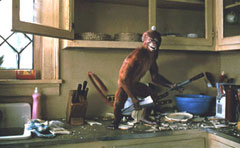
6. We understand that hair is one of the most difficult things to
render on the computer. How close are animators to getting it to look realistic? What
other objects or motions are extremely difficult to animate?
TIM: Creating realistic hair or fur is computationally and labor
intensive. The technology exists for doing it well, but much of the success depends upon
the type of hair or fur and the amount of time given to get it right. A tangled mess is a
different problem than flowing locks, which are different than short and stubbly. The only
way to know how close we are to getting a good match is by the viewer not knowing when
something is computer generated.
Generally, movements that are encountered on a regular basis by the
audience, and lighting that is encompassing, such as sunlight, are very difficult to
synthetically reproduce. So many times we find ourselves laboring over the animation of
objects which are effected by simple physics such as gravity or momentum simply because
our eyes are well accustomed to seeing such events in the real world and we know
immediately when the action is the least bit incorrect. This effect is only compounded
when trying to animate the simple movements of a human -something we experience visually
countless times a day. If placed in very dramatic single source lighting situations many
of the details, and problems can be hidden. Place the same element in bright sunlight and
the behavior of the light becomes a difficult thing to replicate.

7. Any good secrets or trivia about some of the effects scenes we've
seen in the movies?
TIM: The cranillations across the top of the Martians' heads in
'Mars Attacks' spell out "gigem".*
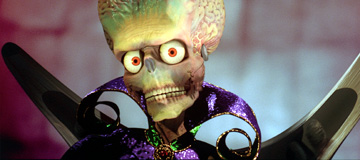
8. We've seen effects go from models, to metallic CGI creatures, to
realistic dinosaurs. What do you personally consider the next hurdle in computer
animation?
TIM: I'm anxious to see a boom in home-made effects. There are
certainly many more bridges to cross on the road to realism, but I'm at this time more
intrigued by the path toward the day when you and me and other creative souls can tell
fantastic stories without needing to win the lottery first. In 'Wired' magazine (2/97)
George Lucas mentions in a sort of off-hand way that that there's "nothing to stop
two guys in a garage from making a film..." Tools, creativity, and drive are the
biggest hurdles, but at least one of those is becoming more accessible.
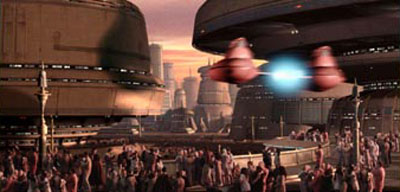
9. Have you got any interesting Star Wars information you can tell
us about?
TIM: My wife, Valerie, got to spend a day on the main stage at ILM
dressed in a grey outfit with a throng of people gathered over a huge bluescreen. Now
she's in 'Return of the Jedi' as a liberated citizen of Cloud City.
Since I'm working on the Prequels I have to work while wearing a
blindfold, and forget everything I've heard at the end of each day. From what I read on
the internet, however, I'm already getting excited about the movie.
10. As Fightin' Texas Aggies, do you find you get the royal
treatment around the work place? :)
TIM: I don't know if I'd call it 'royal' treatment or not. Many of
my co-workers are foreign born or grew up underneath a shell somewhere along the
California coast. They've got a decent, perhaps a bit romanticized, sense about what
'Texan' is. The Aggieness that I exude probably just seems like Texan to them. Meanwhile
I'm adding in little bits of Aggie tradition to the ILM culture as opportunities arise.
Yet, "whoop"-ing when a shot finals might be too scary for some if done without
warning in a darkened screening room.

*I lied on no. 7. The cranillations across the Martian's heads
actually spell out "long live the fightin' Texas Aggie star wars web page. the best
damn site on the net. WHOOP!"
A&M: It's true! It's true! I can see it there? Can you? NO?!
What, are you blind or something? :)

 |

